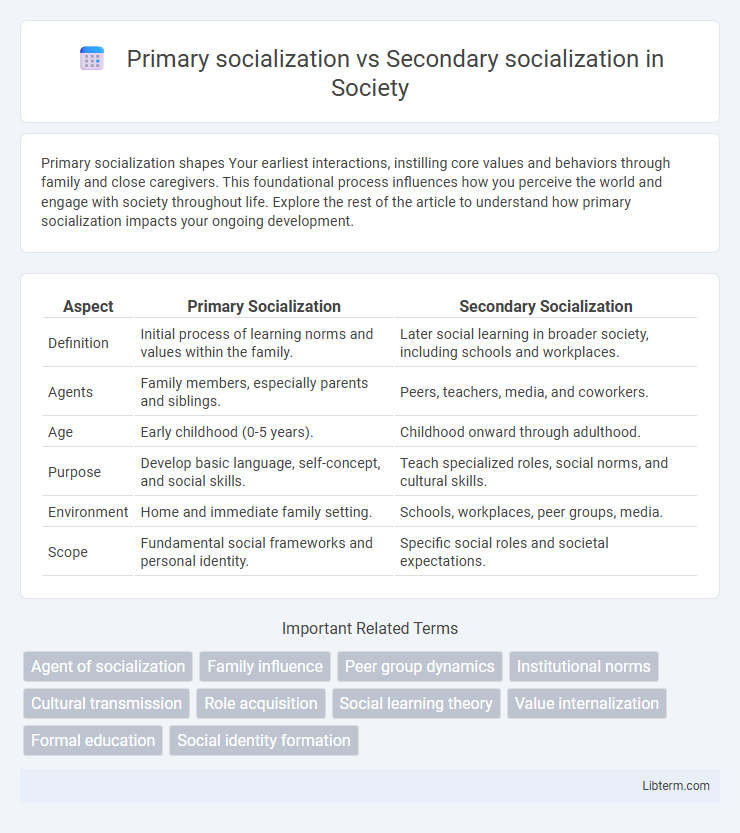Primary socialization shapes Your earliest interactions, instilling core values and behaviors through family and close caregivers. This foundational process influences how you perceive the world and engage with society throughout life. Explore the rest of the article to understand how primary socialization impacts your ongoing development.
Table of Comparison
| Aspect | Primary Socialization | Secondary Socialization |
|---|---|---|
| Definition | Initial process of learning norms and values within the family. | Later social learning in broader society, including schools and workplaces. |
| Agents | Family members, especially parents and siblings. | Peers, teachers, media, and coworkers. |
| Age | Early childhood (0-5 years). | Childhood onward through adulthood. |
| Purpose | Develop basic language, self-concept, and social skills. | Teach specialized roles, social norms, and cultural skills. |
| Environment | Home and immediate family setting. | Schools, workplaces, peer groups, media. |
| Scope | Fundamental social frameworks and personal identity. | Specific social roles and societal expectations. |
Introduction to Socialization
Primary socialization occurs during early childhood, where individuals learn fundamental social skills, language, norms, and values primarily from family members. Secondary socialization happens later in life through institutions such as schools, workplaces, and peer groups, helping individuals adapt to new roles and social environments. Understanding primary versus secondary socialization provides insight into how individuals develop their social identities and function effectively within society.
Definition of Primary Socialization
Primary socialization is the initial process through which a child learns the norms, values, behaviors, and social skills necessary to function within their society, primarily occurring within the family environment. This foundational stage shapes identity, language acquisition, and emotional development, serving as the basis for all subsequent social interactions. Primary socialization differs from secondary socialization by focusing on intimate, direct caregivers rather than larger societal institutions or peer groups.
Key Agents of Primary Socialization
Primary socialization primarily occurs in early childhood through key agents such as family members, especially parents and siblings, who instill basic norms, values, language, and cultural practices. These agents provide the foundational emotional support and social skills necessary for identity formation and social integration. Unlike secondary socialization, which involves peers, schools, and workplaces, primary socialization agents are crucial in shaping an individual's initial worldview and sense of self.
Importance of Early Socialization
Early socialization during the primary socialization phase is crucial as it shapes a child's fundamental behaviors, language skills, and social norms through interactions with family members and close caregivers. This initial stage establishes the foundational identity and emotional development necessary for navigating more complex social environments encountered in secondary socialization, such as schools and peer groups. Delays or deficiencies in early socialization can significantly impact an individual's ability to communicate, cooperate, and integrate effectively into broader society.
Definition of Secondary Socialization
Secondary socialization refers to the process by which individuals learn appropriate behavior and social norms outside the family, typically occurring in settings like schools, workplaces, and peer groups. This stage builds on primary socialization, which takes place in early childhood within the family, by adapting individuals to broader societal roles and expectations. Secondary socialization is crucial for integrating into complex social structures and acquiring skills necessary for adult responsibilities.
Influential Agents of Secondary Socialization
Agents of secondary socialization include schools, peer groups, media, and workplaces, each playing a critical role in shaping an individual's social skills and cultural norms beyond the family environment. Educational institutions foster discipline, knowledge acquisition, and social interaction skills, while peer groups influence behavior, identity, and social acceptance. Media and workplaces further contribute by exposing individuals to broader societal values, professional norms, and diverse perspectives essential for adult social functioning.
Differences Between Primary and Secondary Socialization
Primary socialization occurs during early childhood, where individuals learn fundamental norms, values, language, and behaviors primarily from family members. Secondary socialization takes place later in life and involves adapting to new social environments such as schools, workplaces, and peer groups, focusing on specific roles and social skills beyond the family context. The main differences lie in timing, agents of socialization, and the scope of learned behaviors, with primary socialization shaping basic identity and secondary socialization facilitating integration into broader society.
Impact on Identity and Behavior
Primary socialization, occurring in early childhood within family settings, fundamentally shapes an individual's core identity, values, and basic behaviors through intimate, consistent interactions. Secondary socialization, experienced later in diverse social environments such as schools or workplaces, influences the refinement and adaptation of identity by introducing new norms, roles, and expectations. The interplay between primary and secondary socialization critically affects behavior patterns, with primary socialization establishing foundational social skills and secondary socialization enabling behavioral flexibility and social integration.
Challenges in Socialization Processes
Challenges in socialization processes arise as individuals navigate primary and secondary socialization, facing difficulties in adapting to differing norms and expectations within family and external environments. During primary socialization, children internalize core values and behaviors from close caregivers, but conflicting messages from secondary socialization agents like schools and peers can create identity confusion. The transition between these stages often demands psychological resilience to reconcile foundational social skills with diverse societal roles and cultural influences.
Conclusion: Integrative Role of Socialization
Primary socialization establishes foundational norms, values, and behaviors within the family setting, serving as the initial framework for individual identity. Secondary socialization expands this foundation by adapting individuals to diverse societal roles through institutions such as schools, workplaces, and peer groups. This integrative process enables continuous social development, ensuring individuals effectively navigate and contribute to complex social environments.
Primary socialization Infographic

 libterm.com
libterm.com